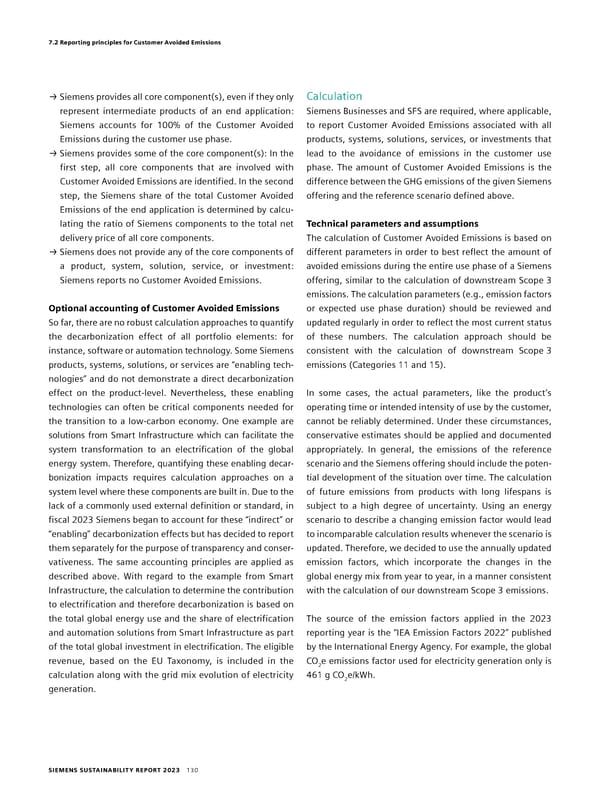7.2 Reporting principles for Customer Avoided Emissions → Siemens provides all core component(s), even if they only Calculation represent intermediate products of an end application: Siemens Businesses and SFS are required, where applicable, Siemens accounts for 100% of the Customer Avoided to report Customer Avoided Emissions associated with all Emissions during the customer use phase. products, systems, solutions, services, or investments that → Siemens provides some of the core component(s): In the lead to the avoidance of emissions in the customer use first step, all core components that are involved with phase. The amount of Customer Avoided Emissions is the Customer Avoided Emissions are identified. In the second difference between the GHG emissions of the given Siemens step, the Siemens share of the total Customer Avoided offering and the reference scenario defined above. Emissions of the end application is determined by calcu- lating the ratio of Siemens components to the total net Technical parameters and assumptions delivery price of all core components. The calculation of Customer Avoided Emissions is based on → Siemens does not provide any of the core components of different parameters in order to best reflect the amount of a product, system, solution, service, or investment: avoided emissions during the entire use phase of a Siemens Siemens reports no Customer Avoided Emissions. offering, similar to the calculation of downstream Scope 3 emissions. The calculation parameters (e.g., emission factors Optional accounting of Customer Avoided Emissions or expected use phase duration) should be reviewed and So far, there are no robust calculation approaches to quantify updated regularly in order to reflect the most current status the decarbonization effect of all portfolio elements: for of these numbers. The calculation approach should be instance, software or automation technology. Some Siemens consistent with the calculation of downstream Scope 3 products, systems, solutions, or services are “enabling tech- emissions (Categories 11 and 15). nologies” and do not demonstrate a direct decarbonization effect on the product-level. Nevertheless, these enabling In some cases, the actual parameters, like the product’s technologies can often be critical components needed for operating time or intended intensity of use by the customer, the transition to a low-carbon economy. One example are cannot be reliably determined. Under these circumstances, solutions from Smart Infrastructure which can facilitate the conservative estimates should be applied and documented system transformation to an electrification of the global appropriately. In general, the emissions of the reference energy system. Therefore, quantifying these enabling decar- scenario and the Siemens offering should include the poten- bonization impacts requires calculation approaches on a tial development of the situation over time. The calculation system level where these components are built in. Due to the of future emissions from products with long lifespans is lack of a commonly used external definition or standard, in subject to a high degree of uncertainty. Using an energy fiscal 2023 Siemens began to account for these “indirect” or scenario to describe a changing emission factor would lead “enabling” decarbonization effects but has decided to report to incomparable calculation results whenever the scenario is them separately for the purpose of transparency and conser- updated. Therefore, we decided to use the annually updated vativeness. The same accounting principles are applied as emission factors, which incorporate the changes in the described above. With regard to the example from Smart global energy mix from year to year, in a manner consistent Infrastructure, the calculation to determine the contribution with the calculation of our downstream Scope 3 emissions. to electrification and therefore decarbonization is based on the total global energy use and the share of electrification The source of the emission factors applied in the 2023 and automation solutions from Smart Infrastructure as part reporting year is the “IEA Emission Factors 2022” published of the total global investment in electrification. The eligible by the International Energy Agency. For example, the global revenue, based on the EU Taxonomy, is included in the CO2e emissions factor used for electricity generation only is calculation along with the grid mix evolution of electricity 461 g CO e/kWh. 2 generation. SIEMENS SUSTAINABILITY REPORT 2023 130
 Sustainability Report Page 129 Page 131
Sustainability Report Page 129 Page 131